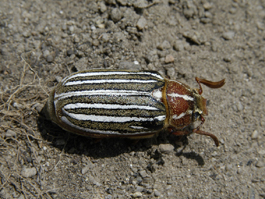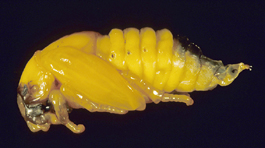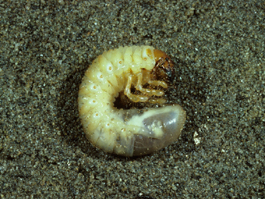by Elizabeth H. Beers, Everett C. Burts, and R.A. Van Steenwyk, originally published 1993
Polyphylla decemlineata (Say) (Coleoptera: Scarabaeidae)
The tenlined June beetle is widely found in sandy soils west of the Rocky Mountains. Larvae feed on plant roots and can weaken or kill the plant. Adults feed on foliage but do not cause economic damage to fruit trees. Infestations spread slowly because of a lack of movement by mated females and the long time span of each generation, which can be up to four years in the Northwest.
Hosts
Hosts of the tenlined June beetle larvae probably include all deciduous tree fruits grown in the Pacific Northwest. Infestations in Washington tree fruits have mostly been associated with apple. The tenlined June beetle has also been well studied as a pest of almonds in California. Other hosts include strawberries, cane fruits, roses, potatoes, corn, and possibly willow and poplar.
In Washington, grubs have been found in areas of sagebrush on sandy soils, although the exact hosts are undetermined. Adults feed on leaves of many broadleaf trees and some conifers.
Life stages
Egg
Eggs are large, oval and a dull, creamy white. They can measure up to 1/6 inch (4 mm) long.
Larva
The grub is a typical C-shaped scarab larvae. The first instar is less than 1/2 inch (12 mm) long, while the full grown third instar is 1 to 2 inches (25 to 50 mm). It has a brown head and three pairs of legs on the thorax. The dark brown contents of the gut can often be seen through the exoskeleton at the tip of the abdomen.
Pupa
The pupa is preceded by a prepupal stage. The pupa is cream to light tan, about 1-1/2 inches (25 mm) long, with external wing pads,
Adult
The adult beetle is 3/4 to 1-1/2 inches (20 to 35 mm) long. It is brown with conspicuous white stripes on the elytra, pronotum and head. Its antennae are distinctly clubbed.
On the male, the lamellae of the club are long, flat, tongue-shaped plates and the club is one and a half times as long as the rest of the antennae. The female has a shorter, more compact club, about 1/2 to 1/3 as long as the rest of the antenna.
Life history
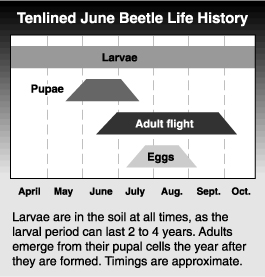 The larval period can last 2 to 4 years in the Northwest, depending on the site and the length of the growing season. Most older grubs are found in the top foot of the soil, where they feed on woody roots, while younger grubs live deeper in the soil and eat the finer and more tender roots. Most of the damage to the tree is done by the older grubs. The grubs begin to pupate in May and June in pupal cells a few inches below the soil surface. The cells are about 2 inches (50 mm) long and 3/4 inch (18 mm) wide pupal period lasts about 5 weeks. Adult activity begins in June or July and continues until fall. The adult bores an emergence hole from the pupal cell to the soil surface but may not emerge immediately. Adults stay under cover during the day, hiding in weeds or grass in the orchard. They make a peculiar wheezy, hissing noise when disturbed. They become active around dusk and are active longer on warm nights. There is little activity when temperatures are below 60°F. Males are attracted to females by a sex pheromone. They mate at or near the female’s emergence hole, and she often lays eggs in the same hole. Dispersal of females may be very limited.
The larval period can last 2 to 4 years in the Northwest, depending on the site and the length of the growing season. Most older grubs are found in the top foot of the soil, where they feed on woody roots, while younger grubs live deeper in the soil and eat the finer and more tender roots. Most of the damage to the tree is done by the older grubs. The grubs begin to pupate in May and June in pupal cells a few inches below the soil surface. The cells are about 2 inches (50 mm) long and 3/4 inch (18 mm) wide pupal period lasts about 5 weeks. Adult activity begins in June or July and continues until fall. The adult bores an emergence hole from the pupal cell to the soil surface but may not emerge immediately. Adults stay under cover during the day, hiding in weeds or grass in the orchard. They make a peculiar wheezy, hissing noise when disturbed. They become active around dusk and are active longer on warm nights. There is little activity when temperatures are below 60°F. Males are attracted to females by a sex pheromone. They mate at or near the female’s emergence hole, and she often lays eggs in the same hole. Dispersal of females may be very limited.
Females lay 60 to 70 eggs in the soil. The eggs hatch in about 3 to 4 weeks. Young larvae feed on decaying vegetable matter or fine roots. They take 3 to 4 years to develop fully. In cold-winter climates, larvae may move deeper in the soil to avoid frost and move closer to the surface again in the spring to continue feeding.
Damage
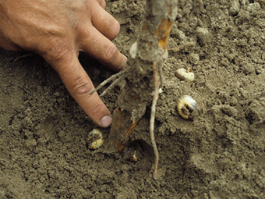
The grubs’ feeding on the roots can weaken or kill the tree. Adults feed on plant foliage but cause little damage.
Monitoring
Problems with tenlined June beetle have most often occurred when a sandy, virgin soil, formerly with sagebrush as the dominant plant, has been planted to orchard. Young trees in this situation that grow poorly, despite adequate irrigation and nutrients, should be examined for grubs. An untreated problem may persist many years after the orchard is planted. Severely affected trees can sometimes be pulled easily from the ground because there are no longer enough roots to anchor them. Sample several trees that appear to be stunted or water stressed. Dig up an area around the tree about 3 feet in diameter and a foot deep and sift through the soil and roots for grubs. With older trees, dig a trench in the herbicide strip in the tree’s root zone and look for grubs.
Adult males can be monitored with a blacklight trap and will also be attracted to ordinary lights during flight. They can be found in large numbers gathered around lights in heavily infested areas in mid- to late summer.
Biological control
Birds eat exposed grubs, while bats and owls attack adults. The grubs are parasitized by a large tiphiid wasp, and adults are parasitized by the flesh fly.
Management
Check for grubs when planting trees into virgin soil where sagebrush has grown. In unirrigated soil, the grubs may have moved down deep to obtain moisture. Where feasible, tilling the soil when grubs are near the surface in spring and summer helps expose them to predators and parasites. Where infestations are severe, trees may have to be removed and the soil fumigated.
